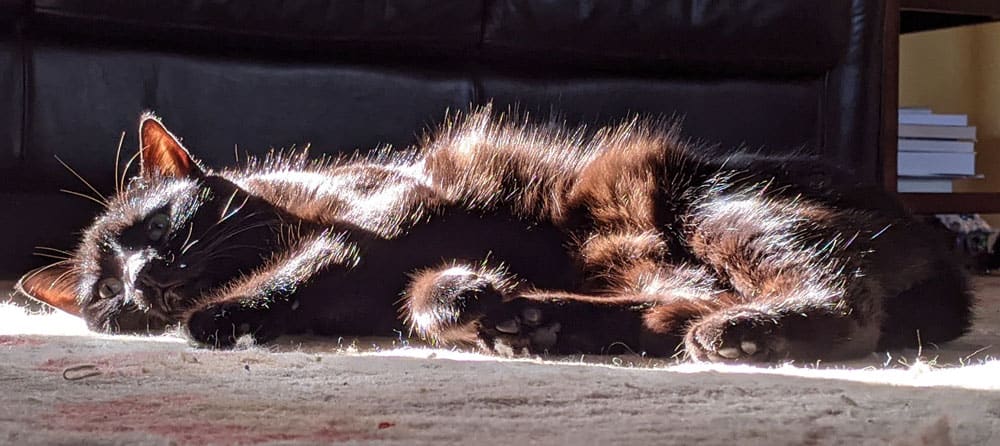If you notice your black cat’s fur taking on a reddish tint, there are two likely reasons for the change in fur color.
Why do some cats have black fur?
A black cat’s fur is black due to the presence of a pigment called eumelanin. Eumelanin is produced by special cells called melanocytes, which are located in the skin and hair follicles. When melanocytes produce a lot of eumelanin, the fur appears black.
The amount of eumelanin produced by melanocytes is determined by the cat’s genetics, specifically the genes that control the production of eumelanin.
Too much sun exposure
Cats have a higher thermal requirement than humans. Cats love to seek out sources of heat. One favorite activity of cats is to find a beam of sun and lie in it. This favorite lounging activity of cats can have an impact on the color of darker cats.
When a cat’s black fur is exposed to sunlight, the eumelanin pigment begins to break down due to the high energy of the sun’s ultraviolet (UV) radiation. This causes the eumelanin to lose its color and become lighter in color, which in turn gives the fur a brown or reddish-brown appearance.

This process is known as photobleaching or sun-bleaching. When black fur is exposed to sunlight, the eumelanin pigment begins to break down due to the high energy of the sun’s ultraviolet (UV) radiation. This causes the eumelanin to lose its color and become lighter in color, which in turn gives the fur a brown or reddish-brown appearance.
The degree of sun-bleaching can vary depending on a variety of factors, including the amount of time the pet spends in the sun, the strength of the sunlight, and the thickness of the fur.

Low phenylalanine and tyrosine in a cat’s diet
Tyrosine is an amino acid that is essential for the production of melanin in cats. Tyrosine produced in the body from another amino acid called phenylalanine. Phenylalanine is an essential amino acid, which means that it cannot be synthesized in the body and must be obtained through the diet.
Phenylalanine is found in a variety of protein-rich foods that are commonly included in cat food, such as meat, fish, eggs, and dairy products. Commercial cat food formulations are typically designed to provide balanced amounts of essential amino acids, including phenylalanine, to meet the nutritional needs of cats.

When cats eat a diet that is low in protein-rich foods, they will also not absorb enough phenylalanine. This in turn affects the production of melanin in a cat’s fur which requires these amino acids in order to produce the darker black pigment known as eumelanin.
Several studies have demonstrated that black cats who don’t get enough tyrosine or phenylalanine in their diets will start to produce more reddish-brown fur. One study showed that black cats have a higher tyrosine/phenylalanine nutritional requirement to maintain their black fur color than current guidelines for pet dietary requirements.
How much phenylalanine and tyrosine is required for cats?
Both the Association of American Feed Control Officials, or AAFCO and the National Research Council, or NRC have guidelines for how much phenylalanine and tyrosine should be in cat food to meet the nutritional needs of cats.
The AAFCO guideline states that both kitten and adult cat diets should have a minimum of 8.8 g phenylalanine plus tyrosine per kg of food, with at least 4 g of phenylalanine. However, studies have found that this recommendation does not appear to be adequate to maintain melanin production in black cats.
One study published in the Journal of Nutrition in 2002 found that cats fed a diet of less than 16g of combined phenylalanine plus tyrosine developed reddish-brown hair. Another study published in 2001 in the Journal of Small Animal Practice similarly found that a diet that contained a combination of 4–5 grams of tyrosine plus 12 grams of phenylalanine per kilogram was not sufficient to maintain black fur color.
Black cats fed an adequate diet with the necessary amount of phenylalanine and tyrosine will regain their black fur.
References
Anderson, P. J., Rogers, Q. R., & Morris, J. G. (2002). Cats require more dietary phenylalanine or tyrosine for melanin deposition in hair than for maximal growth. The Journal of nutrition, 132(7), 2037-2042. https://doi.org/10.1093/jn/132.7.2037
Linder, D. E., & D. (2021, December 21). Why did my pet’s Black hair coat turn red? Clinical Nutrition Service at Cummings School. https://vetnutrition.tufts.edu/2021/12/why-did-my-pets-black-hair-coat-turn-red/
Williams, J. M., Morris, J. G., & Rogers, Q. R. (1987). Phenylalanine requirement of kittens and the sparing effect of tyrosine. The Journal of nutrition, 117(6), 1102-1107. https://doi.org/10.1093/jn/117.6.1102
Yu, S., Rogers, Q. R., & Morris, J. G. (2001). Effect of low levels of dietary tyrosine on the hair colour of cats. Journal of Small Animal Practice, 42(4), 176-180. https://doi.org/10.1111/j.1748-5827.2001.tb01798.x







